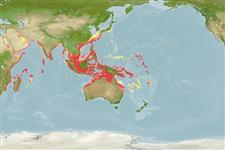Environment: milieu / climate zone / depth range / distribution range
Ecologia
marino; salmastro demersale; oceanodromo (Ref. 51243); distribuzione batimetrica 10 - 90 m (Ref. 12260), usually 20 - 60 m (Ref. 114285). Tropical; 36°N - 28°S, 33°E - 180°E
Indo-West Pacific: East Africa to southeast Asia, north to China, south to northern Australia and Fiji (Ref. 12743).
Length at first maturity / Size / Peso / Age
Maturity: Lm 9.9, range 9 - 10.3 cm
Max length : 23.0 cm TL maschio/sesso non determinato; (Ref. 30573); common length : 20.0 cm TL maschio/sesso non determinato; (Ref. 5450)
Spine dorsali (totale): 8; Raggi dorsali molli (totale): 9; Spine anali 1; Raggi anali molli: 7. This species is distinguished by the following characters: D VIII,9; pectoral fins 15-16; gill rakers 7-8 + 19-21 = 27-28; lateral line scales 34-37; body depth at first dorsal-fin origin 29-33% SL and at anus 25-27% SL; caudal-peduncle depth 11-12% SL; maximum head depth 23-25% SL; head depth through eye 18-20% SL; head length 29-30%SL; orbit length 7.4-8.7% SL; upper jaw length 11-13% SL; barbel length 17-21% SL; caudal-fin length 27-30% SL; anal-fin height 16-18% SL; pelvic-fin length 20-22% SL; pectoral-fin length 24-26% SL; first dorsal-fin height 23-26% SL; second dorsal-fin height 17-18% SL; no bars on caudal-fin lobes; yellowish lower lobe base, grey on upper lobe (some of the caudal-fin lobe pigmentation retained when preserved, including inner margin of fin lobes); 2 yellow body stripes, 1 mid-lateral body from operculum to caudal-fin base (both faintly retained in preserved fish); white barbels; body dorsally pale brown and ventrally white (pale brown with some reddish or darker brown area at mid-body in preserved fish) (Ref. 82903).
Found in coastal waters, entering estuaries (Ref. 30573). Sandy-muddy bottom (Ref. 43239). Forms schools (Ref. 5213). Has appearance of sillaginids when schooling (Ref. 48636).
Life cycle and mating behavior
Maturità | Riproduzione | Deposizione | Uova | Fecundity | Larve
Kumaran, M. and J.E. Randall, 1984. Mullidae. In W. Fischer and G. Bianchi (eds.) FAO species identification sheets for fishery purposes. Western Indian Ocean fishing area 51. Vol. 3. (Ref. 3470)
IUCN Red List Status (Ref. 130435)
Threat to humans
Harmless
Human uses
Pesca: scarso interesse commerciale; Acquario: Commerciale
Informazioni ulteriori
BibliografiaAcquacolturaProfilo di acquacolturaVarietàGeneticaElectrophoresesEreditarietàMalattieElaborazioneNutrientsMass conversion
Strumenti
Special reports
Download XML
Fonti Internet
Estimates based on models
Preferred temperature (Ref.
123201): 24.3 - 29.1, mean 28 °C (based on 1552 cells).
Phylogenetic diversity index (Ref.
82804): PD
50 = 0.5000 [Uniqueness, from 0.5 = low to 2.0 = high].
Bayesian length-weight: a=0.01047 (0.00881 - 0.01244), b=3.10 (3.07 - 3.13), in cm total length, based on LWR estimates for this species (Ref.
93245).
Trophic level (Ref.
69278): 3.1 ±0.1 se; based on diet studies.
Generation time: 1.1 (0.9 - 1.4) years. Estimated as median ln(3)/K based on 21
growth studies.
Resilienza (Ref.
120179): Medio, tempo minimo di raddoppiamento della popolazione 1.4 - 4.4 anni (K=0.5-1.3; tmax=4.6).
Prior r = 0.52, 95% CL = 0.35 - 0.79, Based on 1 stock assessment.
Fishing Vulnerability (Ref.
59153): Low vulnerability (15 of 100).
Nutrients (Ref.
124155): Calcium = 233 [126, 477] mg/100g; Iron = 1.33 [0.62, 2.35] mg/100g; Protein = 17.4 [15.4, 19.7] %; Omega3 = 0.302 [0.178, 0.562] g/100g; Selenium = 58.1 [32.3, 117.3] μg/100g; VitaminA = 17.5 [6.6, 50.9] μg/100g; Zinc = 1.66 [1.06, 2.32] mg/100g (wet weight);
